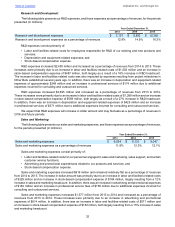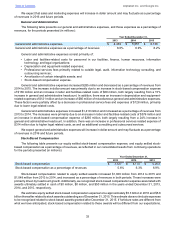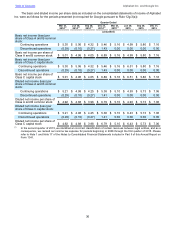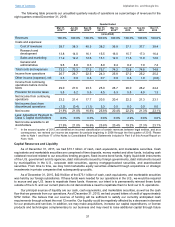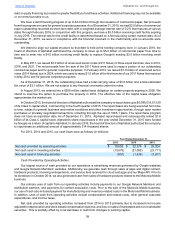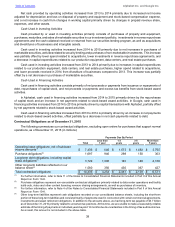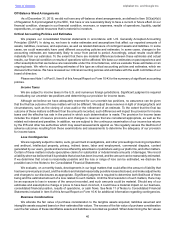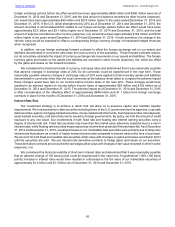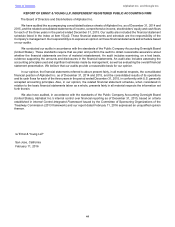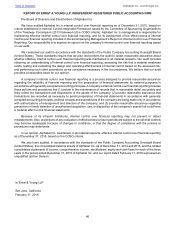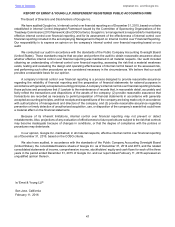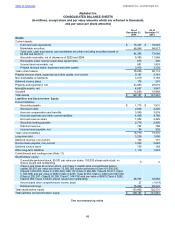Google 2015 Annual Report Download - page 44
Download and view the complete annual report
Please find page 44 of the 2015 Google annual report below. You can navigate through the pages in the report by either clicking on the pages listed below, or by using the keyword search tool below to find specific information within the annual report.
Table of Contents Alphabet Inc. and Google Inc.
40
Off-Balance Sheet Arrangements
As of December 31, 2015, we did not have any off-balance sheet arrangements, as defined in Item 303(a)(4)(ii)
of Regulation S-K promulgated by the SEC, that have or are reasonably likely to have a current or future effect on our
financial condition, changes in our financial condition, revenues, or expenses, results of operations, liquidity, capital
expenditures, or capital resources that is material to investors.
Critical Accounting Policies and Estimates
We prepare our consolidated financial statements in accordance with U.S. Generally Accepted Accounting
Principles (GAAP). In doing so, we have to make estimates and assumptions that affect our reported amounts of
assets, liabilities, revenues, and expenses, as well as related disclosure of contingent assets and liabilities. In some
cases, we could reasonably have used different accounting policies and estimates. In some cases, changes in the
accounting estimates are reasonably likely to occur from period to period. Accordingly, actual results could differ
materially from our estimates. To the extent that there are material differences between these estimates and actual
results, our financial condition or results of operations will be affected. We base our estimates on past experience and
other assumptions that we believe are reasonable under the circumstances, and we evaluate these estimates on an
ongoing basis. We refer to accounting estimates of this type as critical accounting policies and estimates, which we
discuss further below. We have reviewed our critical accounting policies and estimates with the audit committee of our
board of directors.
Please see Note 1 of Part II, Item 8 of this Annual Report on Form 10-K for the summary of significant accounting
policies.
Income Taxes
We are subject to income taxes in the U.S. and numerous foreign jurisdictions. Significant judgment is required
in evaluating our uncertain tax positions and determining our provision for income taxes.
Although we believe we have adequately reserved for our uncertain tax positions, no assurance can be given
that the final tax outcome of these matters will not be different. We adjust these reserves in light of changing facts and
circumstances, such as the closing of a tax audit or the refinement of an estimate. To the extent that the final tax
outcome of these matters is different than the amounts recorded, such differences will impact the provision for income
taxes and the effective tax rate in the period in which such determination is made. The provision for income taxes
includes the impact of reserve provisions and changes to reserves that are considered appropriate, as well as the
related net interest and penalties. In addition, we are subject to the continuous examination of our income tax returns
by the IRS and other tax authorities which may assert assessments against us. We regularly assess the likelihood of
adverse outcomes resulting from these examinations and assessments to determine the adequacy of our provision
for income taxes.
Loss Contingencies
We are regularly subject to claims, suits, government investigations, and other proceedings involving competition
and antitrust, intellectual property, privacy, indirect taxes, labor and employment, commercial disputes, content
generated by our users, goods and services offered by advertisers or publishers using our platforms, and other matters.
Certain of these matters include speculative claims for substantial or indeterminate amounts of damages. We record
a liability when we believe that it is probable that a loss has been incurred, and the amount can be reasonably estimated.
If we determine that a loss is reasonably possible and the loss or range of loss can be estimated, we disclose the
possible loss in the Notes to the Consolidated Financial Statements.
We evaluate, on a monthly basis, developments in our legal matters that could affect the amount of liability that
has been previously accrued, and the matters and related reasonably possible losses disclosed, and make adjustments
and changes to our disclosures as appropriate. Significant judgment is required to determine both likelihood of there
being and the estimated amount of a loss related to such matters. Until the final resolution of such matters, there may
be an exposure to loss in excess of the amount recorded, and such amounts could be material. Should any of our
estimates and assumptions change or prove to have been incorrect, it could have a material impact on our business,
consolidated financial position, results of operations, or cash flows. See Note 11 of Notes to Consolidated Financial
Statements included in Item 8 of this Annual Report on Form 10-K for additional information regarding contingencies.
Business Combinations
We allocate the fair value of purchase consideration to the tangible assets acquired, liabilities assumed and
intangible assets acquired based on their estimated fair values. The excess of the fair value of purchase consideration
over the fair values of these identifiable assets and liabilities is recorded as goodwill. When determining the fair values




